POTTERY

THE ALCHEMIST
You begin with a shapeless lump of wet clay.......
and with a little stirring, or better put, by turning the potter's wheel, a firm line developes
from your fingers.
By firing pots and dishes in the oven with a visible fire,
you slowly see the glazes melt until the surface is of a satin sheen.
Red-hot, the pots are taken out of the fire and put into the sawdust where the green
copper oxide subtly changes into a gold-coloured copper finish.
when all this is successful...
and the pot has no imperfections and has a beautiful crackle...
then I feel myself to be an ALCHEMIST:
or at least...
GALLERY
 |
 |
 |
 |
 |
 |
 |
 |
 |
 |
 |
 |
 |
 |
 |
 |
 |
 |
 |
 |
 |
 |
 |
 |
 |
PERSONAL
 I was born in Amsterdam (The Netherlands) on December 3, 1938. After highschool I completed
a course in the Chemical Department at the HTS of Amsterdam. Afterwards, I started my
professional career at Philips, to improve physical and chemical processes for the
production of electronic parts.
I was born in Amsterdam (The Netherlands) on December 3, 1938. After highschool I completed
a course in the Chemical Department at the HTS of Amsterdam. Afterwards, I started my
professional career at Philips, to improve physical and chemical processes for the
production of electronic parts.
In 1980 my job at Philips provided me with the opportunity to develop technical ceramics
(ceramic devices for electronic apparatus such as computers and mobile telephones).
This was also the start of my work in my free time on the fundamentals of ceramics: CLAY ;
it is great fun to delve with your hands in the "mud" but with your head in the clouds..
And so I found a new hobby (besides tennis and walking in the mountains).
A happy coincidence was that through my work I had the opportunity to visit Japan and also
the "Mecca" of the Raku techniques: KYOTO...
and so arose a great interest in the techniques
and forms of Raku.
After my retirement (at the end of 1998) it was very clear to me that I was
developing as a potter in the tradition of Raku: simple in form with a surprising beauty.
 Ruud Ruijgrok
Ruud Ruijgrok
Strijperstraat 55
5595 GB Leende NBr
tel: 040 2061605
E mail: ruijgrok@alchemist.nl e-mail
TECHNIQUES
The objects are mainly thrown on a potter's wheel or made from sheets of clay.
The clay I work with is from Creaton No. 468 with 40% chamotte (0-0.5mm).
This chamotte (a pre baked clay) is necessary to protect the work pieces against
fracture from the extreme temperature changes during the Raku process.
- Unfortunately, in my experience, the chamotte is not always effective in protecting
big open forms such as bowls,which are notorious for cracks!.-
After drying, the objects are fired for the first time - the so-called biscuit firing -
in an electric kiln at approx. 1000 C. After that, the glaze is applied to the pieces.
The objects are fired in a gas kiln (selfmade) at a temperature of 970-1050 C.
The atmosphere in the kiln can be oxidative or reductive (this has a significant effect
on the colours of the glazes).
The objects are removed from the kiln with a pair of tongs when they are still in a red-glowing state and are immersed in a barrel of sawdust. The effect can vary from a weak to a strong reduction, with a lot of smoke. During the cooling-down stage, the characteristic crackle-effect of the Raku technique appears.
GLAZE
The glazes are made from basic materials and I am often experimenting to improve the
existing recipe or to develop new recipes.
Recently I have done a lot of experiments to find a substitution for Gerstley borate.
For results see Gerstley borate.
CONCLUSIONS
At first instance I tried to “remake” Gerstley borate with a combination of materials which gives the same chemical formulae.
(calculated with my "homemade" glaze program)
This can be realised by the addition of :
fritte 1451, dolomite, whiting, fritte 3221 (or colemanite).
The gas-bubbles formed during the firing of the glaze are produced by the decomposition-gasses CO2 (whiting/dolomite) or H2O
(colemanite).
This can be prevented by using wollastonite and talc as a source of CaO and MgO (although then extra SiO2 is added).
Calcium borate fritte 3221 (Johnson/Matthey) is very suitable as a source of B2O3 and is much better than colemanite
(pinholes).
In the experiments you can see that only nepheline syanite and fritte 3221 is very useful.
The spreadability of the glaze is improved by replacing a part of the nepheline syanite by ball clay.
The end recipe is surprisingly simple:
| Fritte 3221 | 100 gram |
| nepheline syanite | 80 gram |
| Ball clay | 20 gram |
 |
Because of my chemical background I am very interested in the more "fundamental" side of the glaze
and that was the reason to make my own glaze program to calculate the Segerformulae.
An example of this calculation, an experiment with a Barium titanate ( a heritage of my
tech.ceramic period ) is given here. see Seger.
| K2O(0.1)BaO(0.4)ZnO(0.5)Al2O3(x)SiO2(y)TiO2(0.4) | |||
| y=1.5 | 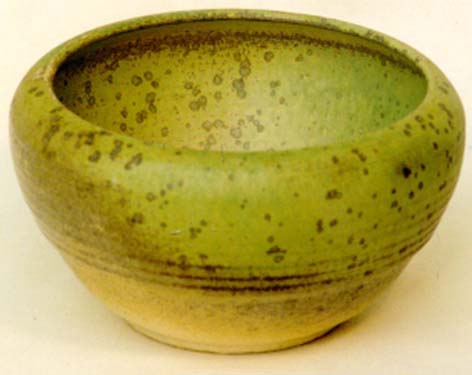 |
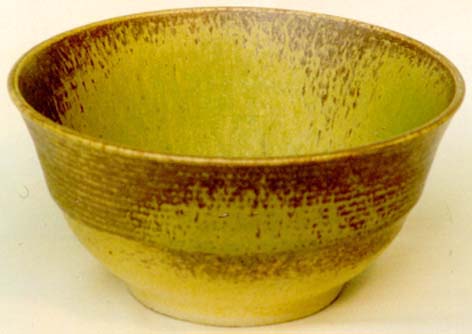 |
 |
| y=2.0 | 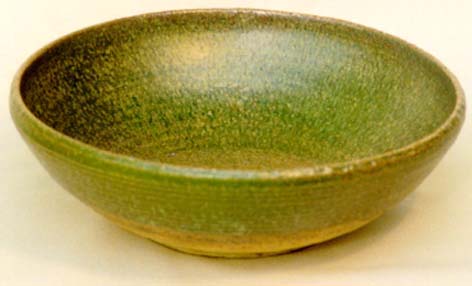 |
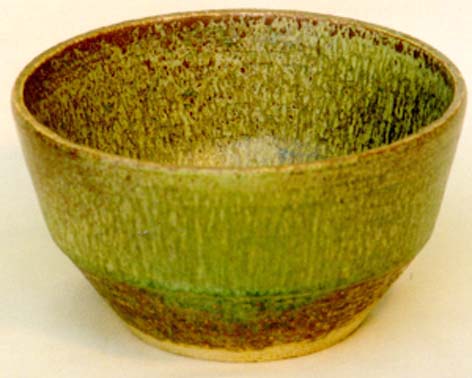 |
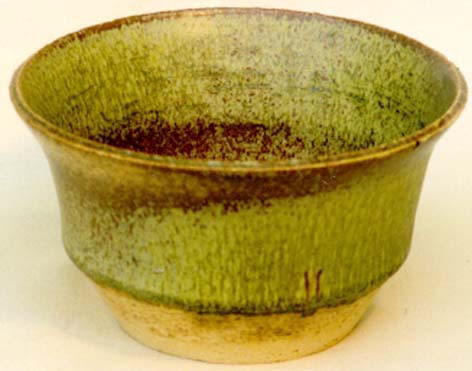 |
| y=2.5 | 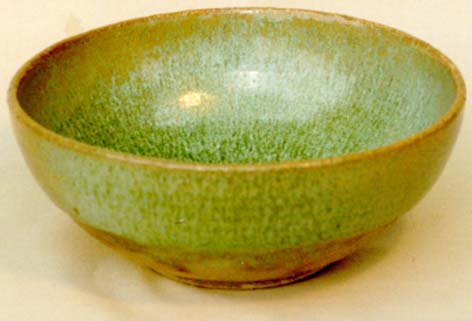 |
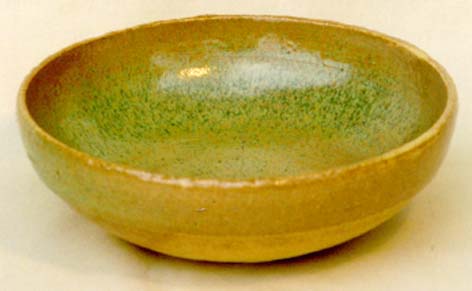 |
 |
| X=0.20 | X=0.25 | X=0.30 | |
The glaze program - written in Excel 2000 - is available free and has other calculations besides the
Seger formulae; the lineair expansion coefficient; the surface tension and the weight % of the oxides.
This calculation can be used for 15 basic materials and for a max. of 25 weight recipes.
THIS IS UNIQUE!!
For inquiries over the glaze program, fill in the supplied form.
As an example, here is a calculation of the crystal glazes from Lasse Östman given in the appendix
MARKETING
This is the most difficult part of the ceramic trade, although youre almost degloved
by the chamotte parts of the clay,throwing is fun, because you are creating something
new and although the disappointment can be very big when the pot breaks,
glazing and firing is fun because of the unexpected; you never know how things will
turn out.
But selling is difficult, because it is hard to let a piece of you go. On the other hand
you cannot let your stock accumulate and you want the "wide world" to enjoy the fruits of my labour.
You can view my work (and get a feel) at:
homeadress after appointment tel: 040-206 16 05
artmarkets
info by e-mail please give the object number
LINKS
for LINKS. click here